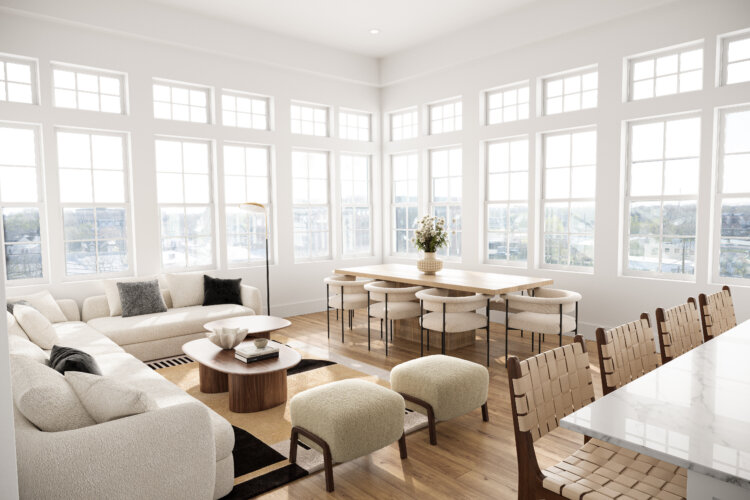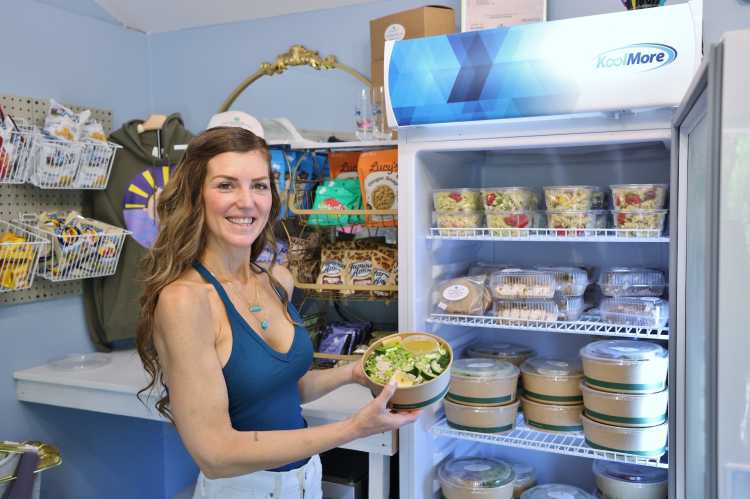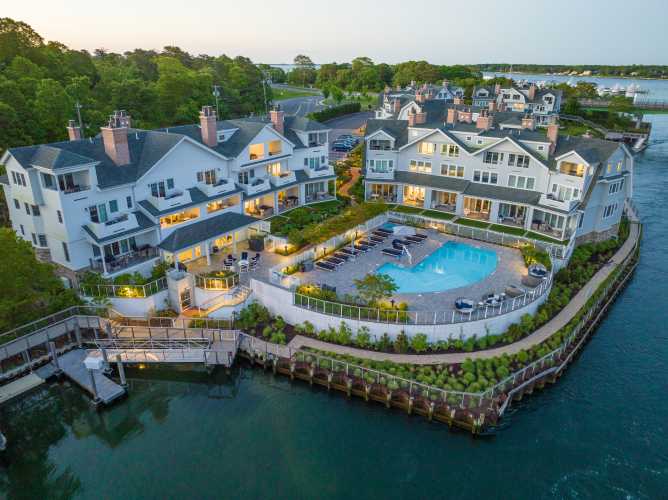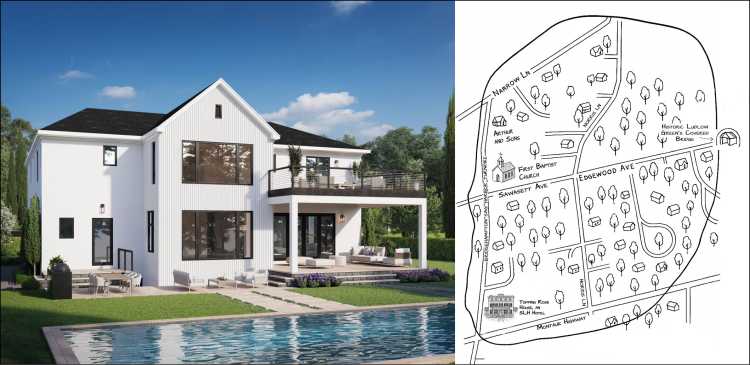In its nearly four-decade history, TRITEC Real Estate Company has evolved from a builder of commercial properties into a developer of vibrant mixed-used communities at the forefront of downtown revitalization on Long Island.
Founded in 1986 by James and Robert Coughlan, TRITEC Real Estate has adapted its business model over the years, focusing more and more on the growing demand for thriving mixed-use projects. Today, TRITEC endeavors to create communities that offer the next level of hybrid living, seamlessly integrating home life, workspace and leisure.
For many years, TRITEC was synonymous with industrial, office and medical development, building about 15 million square feet of space, including hospitality, assisted living, and ambulatory surgical centers throughout the island. TRITEC continues to build these product types for select clients.
“In 2003, we started to explore the need for mixed-use and multifamily on Long Island,” says Christopher Kelly, vice president of marketing.
This strategic shift was in response to the continual exodus of young professionals from Long Island due to a lack of affordable and diverse housing options, notes Kelley Heck, executive vice president and lead developer of TRITEC’s Station Yards and Shoregate projects.
“They’re the ones that are going to be occupying our region’s office and industrial space and become the next generation of workers,” Heck says.
“So, if we can’t keep that younger population around, we need to rethink what we’re doing.”

New Focus with New Village
TRITEC’s inaugural residential/mixed-use development was New Village, a 291-unit complex with 45,000 square feet of retail in Patchogue village, completed in 2014.
When Patchogue Mayor Paul Pontieri invited TRITEC into the community in 2005, about 50% of Main Street was vacant.
“He wanted to create a much more active and vibrant community, and putting feet on the street and adding housing right in their downtown was the thought process behind that,” says Heck, noting that today, there are more than 45 new restaurants and shops in downtown Patchogue.
Since TRITEC’s $112 million investment into Patchogue, Blue Point Brewing Company, Village Walk at Patchogue assisted living facility, and others investors contributed to the successful revitalization of Main Street, and the American Planning Association added Patchogue to its list of Great Places in America in 2019.
“They’re probably close to $1 billion in economic activity in a 2.2-square mile village,” Kelly says. Housing developments in downtown transit-oriented communities tend to attract young professionals, who typically account for about 30 to 40% of TRITEC’s developments, but they also appeal to a large percentage of empty nesters interested in having a coffee or beer or going to the gym just steps away from their homes.
The success of Patchogue has encouraged other communities to welcome similar developments to their hamlets, “to activate Main Street, to help create a vibrant community,” Heck says.
A similar revitalization scenario played out at The Wel Apartments in Lindenhurst, completed by TRITEC in 2021.
When they began the development process for The Wel Apartments, there were just a few restaurants and bars nearby in Lindenhurst.
“By the time we left that neighborhood, there were more than 20 new restaurants on Wellwood and Hoffman avenues,” says Kelly. “So, it creates that kind of vibrancy and walkability and helps restore downtowns to the active communities that they once were.”
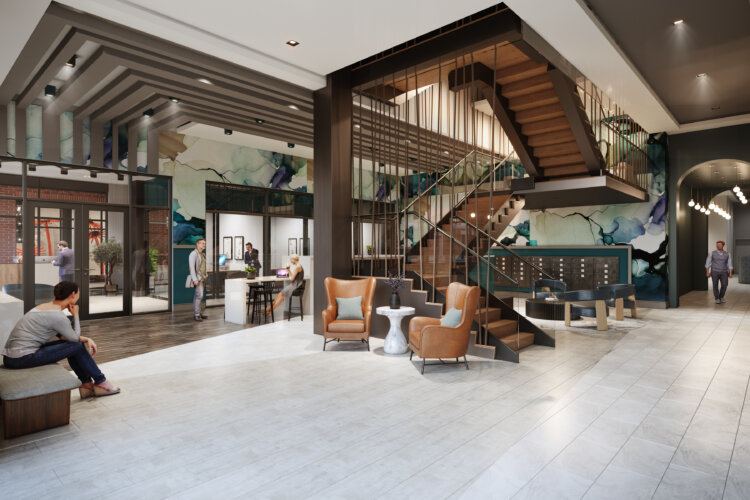
Station Yards: Reinventing Ronkonkoma
In 2012, TRITEC was unanimously selected to become the master developer to re-envision the land on the north side of the Ronkonkoma railroad tracks, and began the process of developing the Ronkonkoma Hub, which is now called, “Station Yards.”
“It was primarily comprised of commercial and industrial properties with a lot of vacancy and blight within those 53 acres,” says Heck, noting that the community had clamored for redeveloping the area since the late 1980s.
When completed, Station Yards will include 1,450 apartments, 195,000 square feet of retail space, 360,000 square feet of commercial/medical space and 60,0000 square feet of hospitality space.
Before any actual vertical construction could happen, $50 million in infrastructure work had to be addressed, including a $36 million sewer pump station connecting to the Southwest Sewer District.
The new pump station created 1.5 million gallons of sewer capacity, of which the Station Yards project will use about 400,000 gallons.
“So, it creates a huge amount of sewer capacity in the middle of Long Island that never existed before,” says Kelly, noting that this has both positive environmental and economic impacts. Alston at Station Yards — Phase 1 of the project — a 489-unit rental complex, was fully completed in 2019.
Currently under construction, Phase 2A includes The Core at Station Yards, 388 residential units, plus an additional 67,000 square feet of retail and 16,000 square feet of office space, including TRITEC’s new headquarters, which are currently based in East Setauket.
Nine tenants — about half of the retail space — have executed leases in Phase 2A.
“And we’re actively negotiating the remaining 50%,” says Heck.

This month, people will be able to move into The Core at Station Yard’s first residential building. Overall, there will likely be five phases of the Staton Yards development. Placemaking is Key Station Yards is a multiyear project with a Town-approved form-based zoning code in place – the first of its kind on Long Island – which defines certain restrictions, parameters and density, but allows for flexibility on the uses and layout in future phases.
“Where and how each phase is developed will largely be based on market demand and financial conditions,” Heck says.
For example, in this current environment, it makes more sense to build multi-family housing than an office building.
“We probably wouldn’t be able to finance a spec office building in today’s market, so having that flexibility is re ally important,” Heck says.
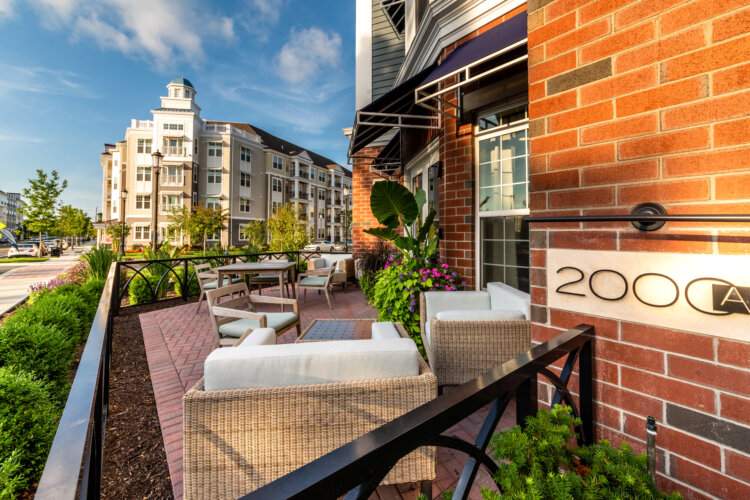
To help with the retail aspect of the development, TRITEC has retained Streetsense, an international retail consulting firm, which advises them on how the retail should be laid out and what the targeted merchandising plan should be.
Placemaking, such as integrating with the surrounding neighborhoods as well as incorporating pedestrian scale design and vibrant public gathering spaces, is a vital aspect of the overall project.
“The purpose of placemaking is to create an atmosphere with character and individuality. You want to foster community and create a sense of place,” Heck says.
To date, all of Station Yards’ retail tenants, including Great South Bay Brewery, VESPA Italian Kitchen & Bar, Tap Room, and Bethpage Federal Credit Union, are Long Island-based companies.
“We recognize that this was the first experience of Long Island for some people who visit here. And we wanted this project to be authentically Long Island,” Kelly says.
Integral to the development of Station Yards is ensuring that it be part of the very fabric of the greater community.
To that end, TRITEC has worked closely with the Chamber of Commerce in Ronkonkoma and the Lake Ronkonkoma Civic Organization, as well as building partnerships with Sachem schools and library, local businesses and surrounding communities.
From its proximity to the train station to its retail offerings, an active central plaza offering concerts and farmers markets, and a myriad of building amenities, Station Yards promises to be a very vibrant community.
“This specific part of the development is full of energy and it’s going to be an exciting place as it continues to develop over the next year and people are really going to be able to lean into that,” says Kelly.
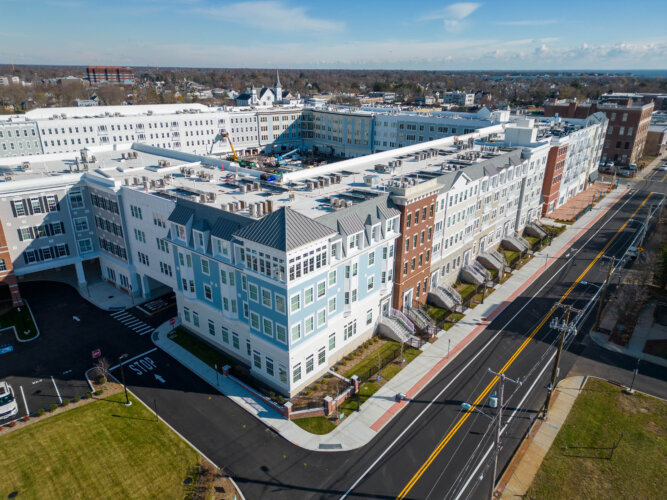
Shoregate Opens Up in Downtown Bay Shore
This November, TRITEC opened phase 1 of Shoregate in Bay Shore, leasing two-thirds of the 418-unit rental development. Phase 2 will open in June 2024.
Sited on a 10-acre parcel one block north of Montauk Highway, caddy corner to the Bay Shore train station and steps away from the Fire Island ferries, Shoregate will also feature 1,640 square feet of retail space.
Shoregate is opening in conjunction with the revitalization of the Bay Shore community, including a combined $1 billion expansion by the two hospitals surrounding Shoregate: South Shore University Hospital and Good Samaritan University Hospital, whose additional healthcare workers can benefit from the new residential complex’s proximity to their workplaces.
The development also includes an affordable housing component, with 20% of the units priced at 80%t of the Area Media Income and the program is administered through the Long Island Housing Partnership.
For both Station Yards and Shoregate, TRITEC included extensive amenity areas, from lounge spaces to game rooms, swimming pools, coworking spaces, fitness centers, outdoor barbeques and firepits.
In Shoregate, there’s also a library, pickleball, bocce and shuffleboard, a golf simulator and a rooftop space overlooking the Great South Bay.
PARTNER CONTENT
This article appeared on the cover of the January 2024 issue of Behind The Hedges Powered By the Long Island Press. Read the full digital edition.
